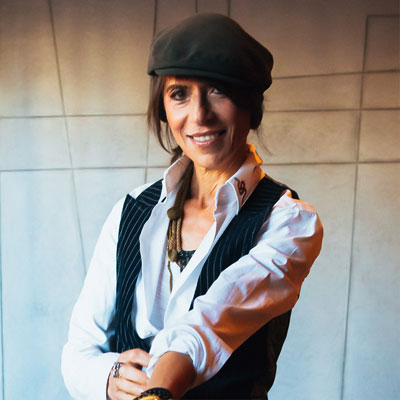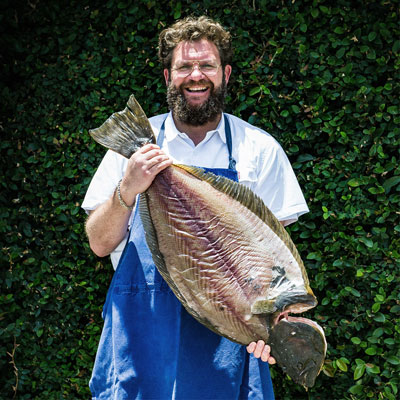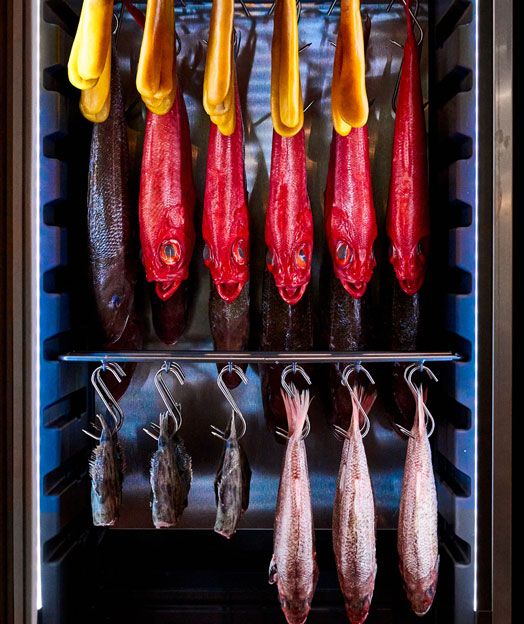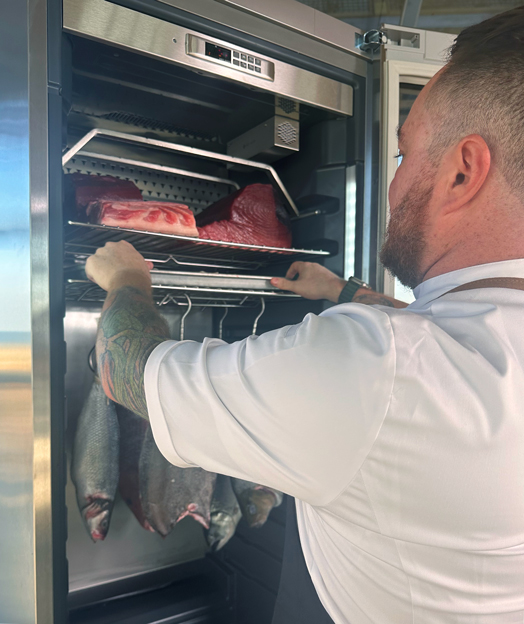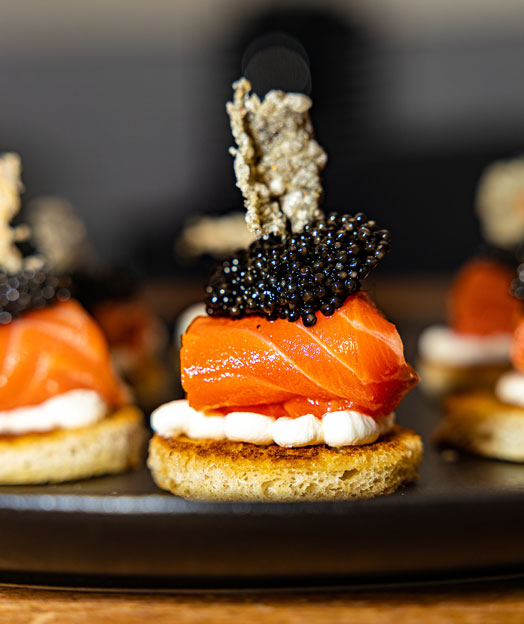
Dry aged is the new fresh
Fish delicacies that are incredibly delicious
For centuries, we believed that fish tastes best when it is as fresh as possible on the plate. Then came the DRY AGER® Cabinet – and with it, thanks to integrated SmartAging® technology bold visionaries among fish enthusiasts in the United States, Asia, and finally in Europe who showed us what happens when you don’t prepare the catch immediately, but allow the fish to mature in the DRY AGER® Cabinet through rest and time. What came out of the experiments of this avant-garde is nothing short of a revolution: Dry aging produces fish delicacies that taste better and more unique while being incredibly long-lasting.

Dry aged fisch
is here to stay
The international gastronomy and gourmet scene embracing the practice
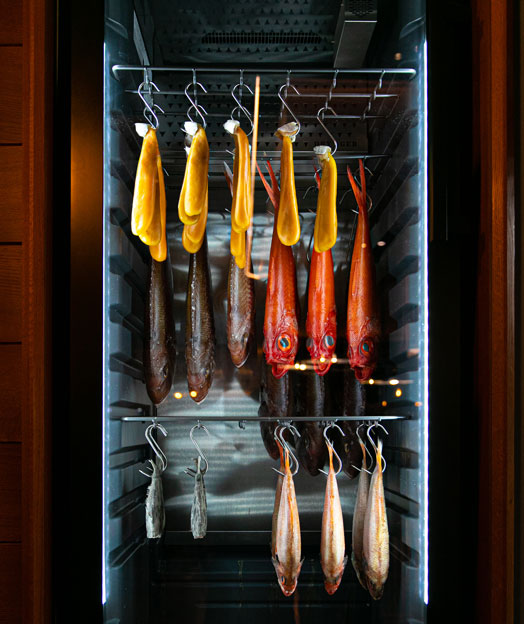
You can enjoy fish delicacies from the DRY AGER® Cabinet raw or prepare them with all known cooking methods. Dry aging refines high-quality fish and also makes handling in your kitchen much easier. In the end, on the plate, there is definitely a piece of culinary uncharted territory: Dry aged fish brings heavenly tender textures and even real, intense umami flavors to the palate. Creative chefs are using this to question the boundary between fish and meat.
When dry aging fish, safety is doubly important
The DRY AGER® Cabinet ensures a steril environment
Similar to meat, the pioneers of fish aging initially tried to dry age their salmon, Hamachi (Yellowtail mackerel), or tuna in conventional refrigerators. However, things can go wrong in the process. The DRY AGER Fish Aging Cabinet is trusted not only by renowned experts in fish aging like Josh Niland in Australia, Liwei Liao, Ray Lee and Mike Colantes in the USA, Master Sushi Chef Hiroyuki Terada or two-star Michelin chef Michael Cimarusti, but also by a growing community of gastronomers, retailers, and connoisseurs worldwide. Even Hamburg-based Sebastian Baier relies on the DRY AGER Cabinet. The legendary functionality of the DRY AGER® Premium S Dry Aging Cabinets with SmartAging® Technology is highly appreciated worldwide.
The DRY AGER® Cabinet creates optimal conditions for dry aging fish, precisely controlling temperature, humidity, and air circulation to achieve the desired level of aging. With DX AirReg®, it ensures a perfect microclimate, optimal airflow, and continuous disinfection. These parameters are crucial when it comes to dry aging fish, as there are only slight nuances of these parameters between perfection and spoilage. Invest in quality and perfection with the DRY AGER® Cabinet for unique flavor experiences.
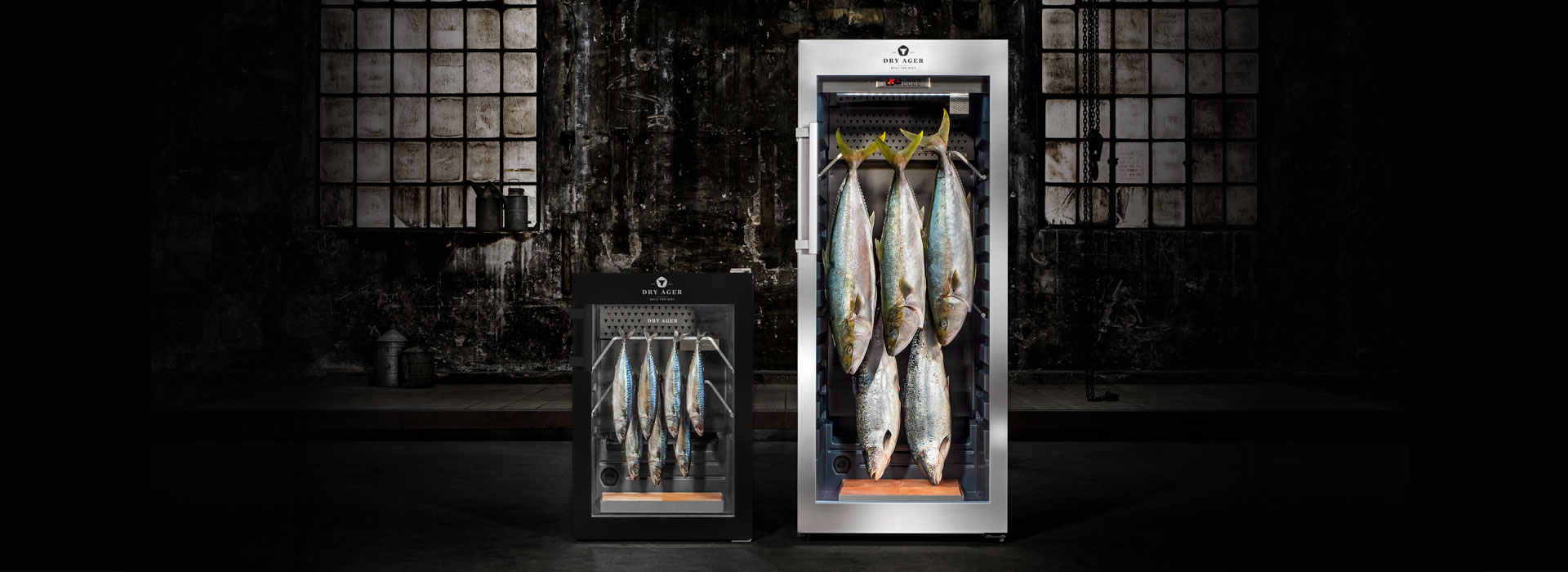
The DRY AGER® Cabinet
Your fish insurance
The delicate proteins of fish are even more vulnerable than red meat. Not a problem for the DRY AGER Cabinet! The DRY AGER Unit with SmartAging® Technology makes fish aging uncomplicated and absolutely safe!

DX 500 Premium S
Compact design,
strong in
technology.
The little one from DRY AGER® makes a big impression with the new SmartAging® technology. With its stylish design, the fish maturing cabinet provides the perfect environment for refining and storing fish – a masterpiece for gourmets and connoisseurs. Thanks to its precise parameters, the DRY AGER fish maturing cabinet guarantees even maturing, taking the taste and tenderness of your fish to an unparalleled level.
Maximum flexibility: for example, up to 10 kg of fish can be matured or stored in the appliance at once.
DX 1000 Premium S
More space
for first-class
delicacies.
So big that every fish wants to dive into it. You can now mature like a pro thanks to SmartAging®. Freestanding or integrated into the wall, the DRY AGER® fish maturing cabinet is a real eye-catcher in any seafood counter, restaurant, butcher’s shop, hotel or hobby room and transforms every fish into a culinary masterpiece. From tender salmon to delicious tuna – experience the incomparable taste of perfectly matured fish.
Maximum flexibility: The stainless steel hanger supplied and the optional slide-in grids allow you to mature up to 50 kg of fish at a time.


Ray Lee
Akikos restaurant – San Francisco
Utilizing aging fish techniques entails storing fish in a precisely controlled environment with specific temperature and humidity levels. When executed with precision using DRY AGER® unit, this method can elevate the flavor, texture, and shelf life of the fish, ultimately contributing to an enhanced Omakase experience at AKIKOS and Friends Only.
Website
John Black
Chez Noir – Carmel by The Sea
The DRY AGER® Cabinet enhances the quality, texture, and flavor of what many consider not prized fish to that of exquisite. Rockfish and Black Cod go from your standard run of the mill seafood available here to the most succulent and beautifully textured fish that truly set it apart from other establishments serving the same item!
Website
Dominique Crenn
Atelier Crenn – San Francisco
DRY AGER® has transformed my menu. The texture and flavor imparted to our dry-aged fish is unparalleled, transforming ordinary product into the extraordinary. In my culinary journey, I have yet to find a better, more precise solution for enhancing the essence of fish. It is taking our dishes to new heights. DRY AGER® Cabinet is, without a doubt, the most essential piece of equipment at my restaurant, and I can’t imagine my kitchen without it.
Website
Michael Cimarusti
Providence – Los Angeles
As a new adoptee to the practice, using the DRY AGER® Cabinet has really opened my eyes to the possibilities that come with dry aging fin fish.What I find dry aging reveals in most fish is fat and, secondly of course, flavor. Having the DRY AGER® Cabinet has allowed us to bring more fish in at one time…and the quality and flavor of the meat is head and shoulders above what it was before we used the DRY AGER® Cabinet.
Website
Josh Niland
Australia
The DRY AGER® Cabinets have proven to be an exceptional inclusion to our dry aged fish program we have at Fish Butchery. What has been most exciting for us is the use of the open shelving within both cabinets for dry ageing flounder, flathead & small mackerel. It allows these small fish to be well ventilated & the controls of the cabinet allows us to have great success conditioning the texture internally whilst improving the skin as well. The results we have seen over the past months are extraordinary and as we continue to work with DRY AGER we hope to see even greater outcomes for fish.
Website
Rui Gaudêncio
The finest cut – Switzerland
Typically done with meat, some fish are highly suitable for the dry-aging process too. The process involves hanging the fish in a controlled environment for a few days to several weeks, or even months, allowing natural enzymes to break down the fish’s proteins and fats. Apart from the extended shelf life, this process results in fish with a more concentrated, complex flavor and an enhanced texture. For our process, the Dry-Ager is the best partner in “crime”.
Website
Niklas Herpertz
LaGoonery – Germany
With our DRY AGER® maturing cabinets, we transform regional fish into culinary highlights: Maturing in the DRY AGER® maturing cabinet emphasizes the fresh fish taste and gives it a silky texture – our fine dining customers are delighted!
Website
Liwei Liao
The Joint – Los Angeles
When I first started dry aging fish, we were utilizing our own fridges and I was on the market looking for a professional unit where I could actually control all the aspects of the conditions I age my fish in. Temperature is very critical, relative humidity is very critical, UV is very critical. These units have all these 3 conditions within my control… The DRY AGER® Units are very reliable; I’ve used them for just over two years and I’ve never had any issues with them. I utilize these guys for my most expensive fish, and all my long term aging because they are very stable and very reliable.
Website
Stay clean
Blood and water – everything must go
The golden rule also applies
to dry aging fish:
Quality matters.
The DRY AGER® Cabinet cannot transform a bad starting product into something incredible. Dry aging can only enhance fish that is absolutely fresh, and that has been caught and gutted in the proper way. Therefore, catches from deep-sea trawlers, where stress and fatigue lead to acidified fillet muscles, are not suitable. Ideally, individually caught or angler-caught fish weighing over 1 kg are suitable for aging. These fish should be slaughtered immediately after being caught using the increasingly popular Japanese Ike-Jime method. Only this process guarantees the complete bleeding and complete relaxation of the fish, which is essential for the success of your dry aging project. Numerous suppliers and retailers now offer this, and as a hobby angler, you can find suitable tutorials online.
How chemical processes become a culinary experience.
What happens during
dry aging of fish
Proteins, enzymes, and amino acids
Dry aging is a
scientifically
proven process.
In Japan, sushi masters have known for centuries that every fish needs a certain time to age in order to develop its perfect flavor. Experienced fishmongers in Europe also let fattier fish species rest for a day or two before consumption – for example, fresh-caught halibut initially smells musty like old eggs. However, only the adjustable air in the DRY AGER® Fish Aging Cabinet allows for targeted and controlled aging of fish, turning them into an unimaginable delicacy. Under germ-safe conditions and with the additional protection of the skin, the fillets only lose their culinarily-unnecessary moisture but do not become dry. Enzymatic processes break down long-chain proteins, while amino acids, fats, and glycogen transform, resulting in tender and juicy fillets.
Umami, texture, intensity, aroma
Sensationally complex flavors
In the end, an unprecedented umami aroma emerges in the fish, the taste becomes more complex and intense, pleasantly “seafaring” but never fishy. The skin is dry, free of mucus and odorless, and the fillets have a silky-elastic texture with a pleasant, subtly buttery mouthfeel. Fattier varieties like tuna, swordfish, bonito, or large mackerel species gain a greater flavor clarity due to blood removal, and their texture can resemble dry aged beef fillet, while the aroma becomes even more refined, leaning towards delicate nuttiness. The perfect aging time varies from fish to fish, ranging from a few days to several weeks.
Avoid overcooking
Versatile
preparation options
Dry aged fish can be prepared in almost as many ways as fresh fish, but its strength lies in raw consumption, lightly seared as tataki, or cooked to a translucent texture using sous vide. Aged fish can also be grilled much better once portioned. However, overcooking is fatal, and it’s well known that fresh fish doesn’t tolerate overcooking either.

Save the world for a moment?
Contribute to sustainability with dry aged fish
With such a tremendous amount, all the sustainability benefits of dry aged fish are merely a drop in the bucket. However, the underlying technique still shows a way for you to handle the resources of the globally threatened fauna more responsibly in the future. Just like with meat from the DRY AGER®Cabinet, dry aged fish ensures that we don’t consume these foods thoughtlessly but learn to appreciate them as valuable delicacies – thereby reducing their consumption or even waste.
Dry aged fish also offers the benefits of extended handling over days to weeks, which can contribute to sustainable resource management. There is no need to dispose of fresh fish that becomes inedible after three days of storage. Following the nose-to-tail movement, more and more chefs and manufacturers in the fish aging scene are working according to the scale-to-tail principle, meaning they culinarily process every part of the fish from scale to tail. While this may not save the world, it gradually makes it a better place for both humans and animals.
FAQ
Frequently Asked Questions
- Which fish species are suitable for dry aging?
- The most suitable are fatty ocean fish such as halibut, hamachi, mackerel, amberjack, yellowtail, tuna, bonito, salmon, swordfish, black cod, or barramundi. Dry aging is less effective with fish that have loose muscle structure, such as John Dory, sea bream, whiting, or flounder. Generally, saltwater fish are more suitable than freshwater fish, as the salt in seawater helps protect against bacterial growth. However, with meticulous hygiene, carp, trout, or pike-perch can also be excellently dry aged.
- What should I consider when buying fish for dry aging?
- The raw material, if possible, is individually caught (not in large nets) a few hours ago, transported chilled, and has not been gutted yet. Ideally, the fish was slaughtered using the Ike-Jime method and has had no contact with water after bleeding. Many suppliers who also serve top gastronomy can provide such products. If you are a hobby angler or fisherman, none of this is a problem anyway as you can ensure the proper handling first-hand.
- What is the Ike-Jime method?
- In this method, the fish is killed with a targeted brain puncture. Immediately after that, the gill cut starts bleeding, and a wire inserted through the spinal cord terminates postmortem motor reflexes, making the fillet muscles even more tender. In the end, the fish slowly bleeds out completely in ice water, which is essential for later hygienic dry aging. There are plenty of good tutorials available online for this method.
- How long should I age fish in the DRY AGER® Cabinet?
- The ideal aging time not only depends on the fish species but also on each individual fish. Flatfish such as halibut or sole age similar to complete sides with skin of salmon, cod/skrei, or tuna for only a few days, while large fish with skin age for 21 days to approximately 4 weeks. Specialty products such as wild salmon pastrami or hamachi ham can remain in the DRY AGER® for up to 6 months.
- How does dry aged fish taste?
- Dry aged fish is definitely not fishy in any way but rather has a noble-nutty, complex, oceanic, and intense flavor with surprisingly robust umami notes. The texture remains juicy but becomes slightly firm, marzipan-like, and silky. Compared to fresh fish, dry aged fillets have a much wider flavor spectrum.
- Can I hang fish and meat together in the DRY AGER® Cabinet?
- We do not recommend aging meat together with fish. That’s why you can now see separate DRY AGER® Cabinets for fish and meat in many top restaurants worldwide. In any case, before filling your DRY AGER® Cabinet with other products, make sure to clean and disinfect it.
- What should I consider when filleting dry aged fish?
- When filleting fish from the DRY AGER® Cabinet, you can experience several positive surprises: the fillets detach from the skin more easily and provide your knife with just the right amount of resistance to cut perfectly precise portions, for example, for sushi and sashimi. Large fish, from which slices are cut perpendicular to the muscle fibers, can be gradually filleted and hung back in the DRY AGER in between. It is very important to cover the cut surfaces with parchment paper to protect them.
- How do I prepare dry aged fish?
- You can prepare dry aged fish just like fresh fish, meaning it can be consumed raw, briefly seared, grilled, poached, steamed, or cooked sous vide. The key is not to overcook it. The enhancement provided by the DRY AGER® Cabinet is best showcased when serving the fillets raw, such as sashimi and tartare, or marinated as ceviche, tiradito, or crudo. When preparing fillets in a pan, it’s best to sear them on the skin side until the surface of the fillet becomes lukewarm. Once the fillet has warmed,flip them, remove the pan from the heat, and finish cooking briefly. Highly aged tuna or salmon can also be pan-fried in thicker slices, similar to beef fillet, and served with a veal jus, while carp cut into chops can be grilled briefly and harmonize with a whisky-based BBQ sauce—the line between fish and meat blurs.
- How long can I store dry aged fish?
- You can leave large fish, from which portions are filleted, hanging in the DRY AGER® Unit for an additional 1-2 weeks. If a longitudinally separated fillet from the dry aging process is not fully consumed, the remaining portion can be vacuum-sealed tightly and stored in the refrigerator for up to 14 days.
- Which preset programs of my DRY AGER® Cabinet are suitable for fish aging?
- The DRY AGER® Cabinet with SmartAging Technology (Premium S models) offers two programs for the maturation of fish.
Whole fish: P14
Fish fillet: P15. - What mistakes should I avoid when dry aging fish?
- A lot of problems can occur if the initial product is faulty, meaning it still contains traces of blood, hasn’t been thoroughly cleaned, or comes from a catch where the fish was subjected to severe stress. It is also crucial to maintain absolute hygiene during preparation – it’s best to wear silicone gloves when handling the fish during the aging process in the DRY AGER® Cabinet. Additionally, you should always keep everything as dry as possible around and inside the fish. And of course, it should never start to smell fishy. As a precaution, you can check every 3-4 days if the pH level in the fillets remains relatively unchanged. If it drops significantly, you should avoid consuming the fish.
Are you interested in
our aging cabinets?
Contact us now!
We look forward to hearing from you!
![]()
+49 7581 90 43 0
Monday to Friday: 8:00 – 17:00











